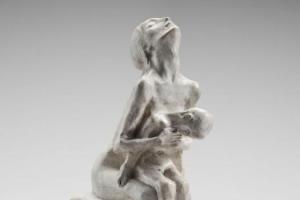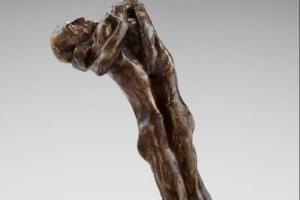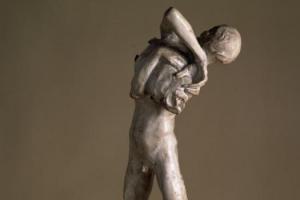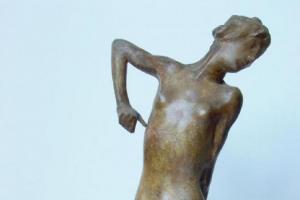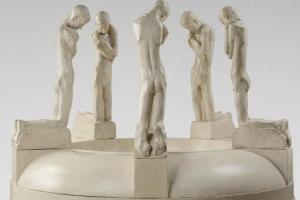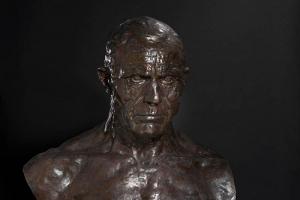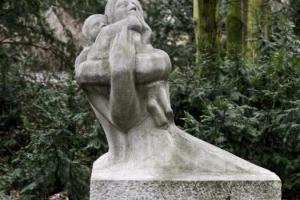George Minne as sculptor
George Minne holds a distinct place in European Symbolism, as sculpture, draftsman and graphic artist. The medium of sculpture is not evident in that Symbolism. However, one of the distinguishing characteristics of Symbolism is precisely the veiling of the visible reality. By suggesting through a new world of dream and reflection, Symbolism alludes to an unspoken, interior emotion and goes against traditional sculpture that since the Renaissance represented the human figure in a realistic way. With his sculptural works-and also in his drawings-Minne thus goes radically against the idealistic artistic views of the academies and against the social realism of the 19th Century. He grounds himself, however, upon the existing themes, but he simultaneously adds a universal character to them. By making abstract from the telling aspect of the chosen themes, he arrives at a new iconography.
From the some 100 sculptural works that are known by Minne, more than two thirds of them originate from after 1900. However, the works that are before 1900 are the most authentic and most moving sculptures. In 1886 we see an artist, barely 20 years old, who for that moment develops a totally new, anti-classical and primitive language of form in the art of sculpture. With humble, moulded, delicate figures on a modest format, called ‘flippant trinkets' by the conservative press, the young artist reached a remarkable monumentality and he gave expression to a deep human spiritual feeling. In the sketchbooks from the period between 1886 and 1900, we see how Minne as a sketcher sought for the sculptural solution. In order to follow the creative process of various sculptures the sketchbooks are an important source of information.
Minne is no sculptor in the literal sense of the word. During his whole life he moulded his images in clay. The execution in plaster was also something that he normally did himself. The fine plaster material also rendered the delicate model of the sculptures. However, for the bronze castes or marble, bluestone or wood hewn version, Minne always called upon other practitioners. He was thus also not always involved with the production itself, which explains partially the uneven quality of his bronze-caste sculptures. The problem of authenticity is, however, thus more complex, in that even after Minne's death, sculptures were still caste and distributed.
Minne presented for the first time in exhibition in 1989 at the tri-annual Salon of Ghent, a year later with Les XX in Brussels. From 1890 on, he exhibited annually, first at Les XX, then later La Libre Esthétique in Brussels. The artist achieved international renown only with his participation in the Wiener Secession in 1900, where he showed, among others, the Kneeling Youth and the Fountain with Kneeling Youths from 1898, the highpoint in the oeuvre of the artist and also in the symbolist sculpture of the fin de siècle.
Between 1897-1899 a few works appeared that were closely linked with the ornamental Art Nouveau style, such as the Small Injured Figure from 1898 and the Woman Bathing from 1899. Also, the wooden image, The Bricklayer from 1897, originally meant for a stairwell in a home designed by Horta, was associated with the art-nouveau view in which sculpture took on a decorative function within interior design.
After 1900, Minne seems to have not been able to find the same creative drive as before. He still took on numerous assignments for portraits and memorial drawings and made replicas from previously made sculptures, in particular the Kneeling Youth. Around 1910 Minne went through a period of stylistic crisis. He abandoned every form of style and radically chose for a realistic approach from his model. After World War I, the theme of Mother and Child loomed large and Minne took up again a number of sculptures from his earlier period, such as Mother Grieving over her Dead Child. Thus he made in the 1930's also two replicas of the Fountain with Kneeling Youths; one is placed in the Emile Braunplein in Ghent and the other on the backside of the Parliament in Brussels. However, the later versions are missing the strong line and expressive emotion that are so distinguishing for the work prior to 1900. With there decorative and polished form the much more belong to the decorative art-deco style of the time.
Helke Lauwaert

